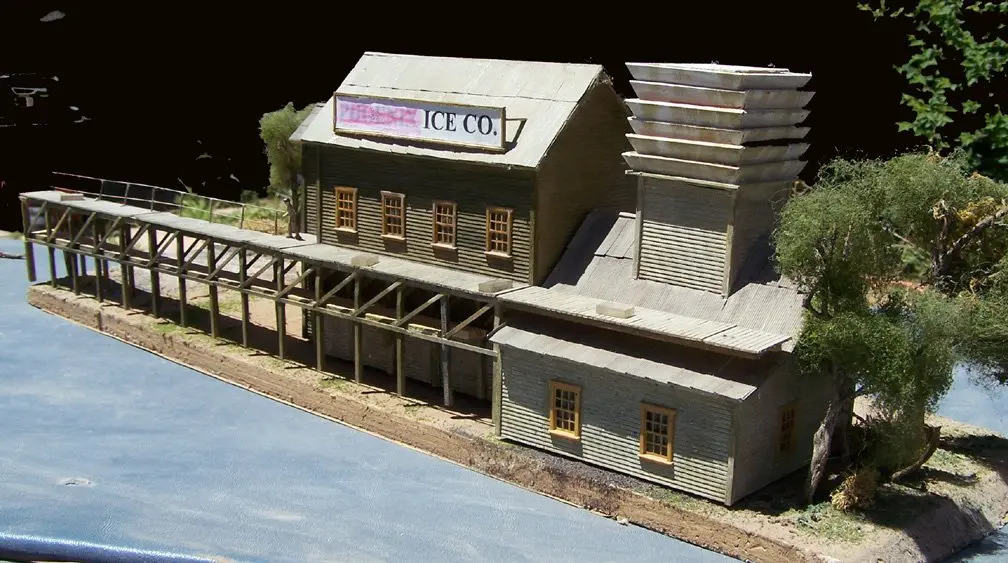I had an Icehouse, but it was too wide for the available space on the layout. This structure measures 4″ X 18″ and three Reefers can be spotted for icing at a time. The story behind this structure is as follows. My oldest son and I were in Durango Colorado, visiting with Ruth and Leo Campbell to purchase Campbell Scale Models. After an all-day discussion about their business, it occurred to me about my “Icehouse” dilemma. I ask Leo, “do you have an Icehouse kit planed for the future?”. Leo said, “I do.” Can you show it to me, “I asked”? He shook his head, “No.” When I got home, I drew up this plan, made the model from Campbell parts, took a picture of it and sent it to Leo. A few days later, I called him to see what he thought about my model, and It was made from Campbell parts I said? All he gave me was a “Humph,” then said it looked beautiful.

ICE HOUSES
Ice houses were a new concept when the country’s railroads finally began to use them to replenish the ice necessary to keep their customers’ perishable items from spoiling in transit. Railroads were reluctant users of refrigerated cars in the first place, but large shippers such as meat packers, breweries, and produce suppliers demanded they use this method to ship perishable goods. Railroads maintained ice houses for the purpose of filling refrigerated freight cars and providing ice for early passenger car conditioning. These operations were usually at major terminals.
HISTORY
Icehouses hark back to the era before railroads began using diesel to refrigerate freight cars. In those days, the only way perishables could be kept cold was by loading ice into bunkers at either end of the car. It is difficult to find the exact year the first icehouses were built. However, in a July 26, 1907, Sentinel story it was reported that the Grand Junction ice plant was running low on ice for domestic use. (Before electric refrigerators were available, “the iceman” made daily deliveries of blocks of ice from that plant to residents, most of whom had “iceboxes” on their back porches.) Arrangements were made with the railroad company to borrow 30 to 35 tons of ice to get Grand Junction residents through the remainder of the summer. The local plant promised to replace the ice during the next winter. A fire destroyed the ice houses, freight depot and merchandise cars with all the merchandise inside on Sept. 23, 1918. According to the headline, the entire city of Grand Junction was endangered. With the booming fruit industry, the railroad quickly built four new icehouses to keep pace with the growing number of packing sheds on the western slope. One of those four was destroyed by a fire on Aug. 30, 1947. When one of these icehouses went up in flames it was one heck of a fire to fight. The icehouses were constructed of two sections six inches apart, filled with sawdust. The roofs were covered with tarpaper. These icehouses were gigantic; each one measured 120 feet long, 80 feet wide, and 40 feet high and stored up to 33,000 tons of ice.
Hundreds of men were employed in producing the ice and packing it in the bunkers. A slide with chutes at different levels was located at the rear and center of each building. Blocks of ice would go down the chute to a platform outside, where the workmen would load the ice into the bunkers. One car could hold 10,000 pounds of ice. Railroads would have man-made reservoirs, usually around 14 inches deep. Each winter, workers would flood the reservoirs. When the water was frozen, the ice harvest would begin. Among the tools used were jig saw, circular saw and large tongs. The men would cut the ice into large slabs, which were then floated through the water to a spot where they were plucked out, placed on a conveyor belt and planed into 300-pound ice blocks. These blocks were then loaded onto a rail car in layers of ice and sawdust and transported to the railroad, where they were transferred from rail car to the icehouse. The last ice house was demolished in 1972 with the introduction of artificial refrigeration.
SOURCES
- http://www.michiganrailroads.com/ice-houses-facilities
- https://www.abebooks.com/Colorado-Railroad-Ice-Houses-William-Reich/30258645409/bd
- http://www.historic7thstreet.org/remembering/pdfs5/icehouses.pdf
